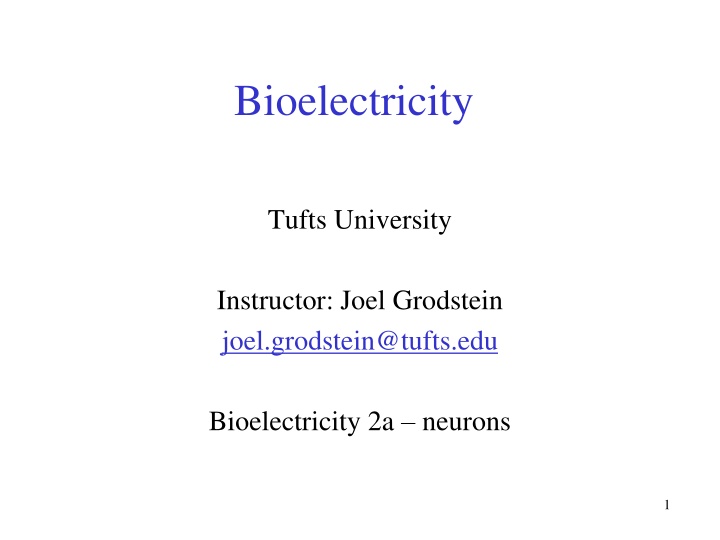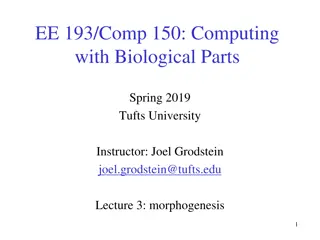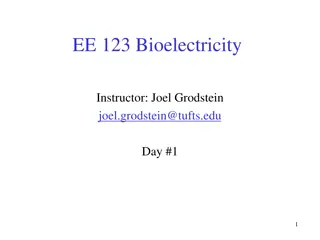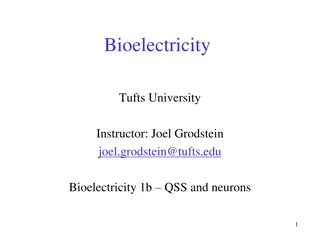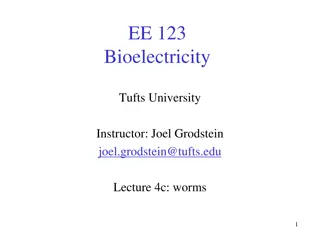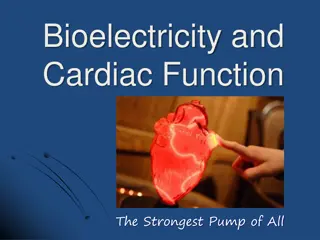Bioelectricity
Explore the fascinating world of bioelectricity with a focus on neurons. Gain insights from Joel Grodstein's instruction at Tufts University. Dive into the complexities of bioelectricity and its implications in the field of neuroscience.
Download Presentation

Please find below an Image/Link to download the presentation.
The content on the website is provided AS IS for your information and personal use only. It may not be sold, licensed, or shared on other websites without obtaining consent from the author.If you encounter any issues during the download, it is possible that the publisher has removed the file from their server.
You are allowed to download the files provided on this website for personal or commercial use, subject to the condition that they are used lawfully. All files are the property of their respective owners.
The content on the website is provided AS IS for your information and personal use only. It may not be sold, licensed, or shared on other websites without obtaining consent from the author.
E N D
Presentation Transcript
Bioelectricity Tufts University Instructor: Joel Grodstein joel.grodstein@tufts.edu Bioelectricity 2a neurons 1
Big picture of the course Where does bioelectricity come from? Neurons and working with the nervous system Cardiac bioelectricity Worms How a single neuron works Lots of neurons the nervous system EMG, prosthetics, NCS, SCS, PNS, electroceuticals Bioelectricity Joel Grodstein 2
Turning off cytokine storms Can you explain the science here? www.setpointmedical.com (white paper at https://setpointmedical.com/sp- content/uploads/2018/09/Setpoint_Medical_White_Pap er_digital.pdf ) https://spectrum.ieee.org/the-human- os/biomedical/devices/handheld-vagus-nerve- stimulator-gets-emergency-approval-for-covid19-use Bioelectricity Joel Grodstein 3
Why neurons? Why do humans have neurons? Bacteria don t have neurons, and they do fine Humans have brains and bacteria don t Bacteria can think without brains! On Having No Head: Cognition throughout Biological Systems, 2016 https://www.youtube.com/watch?v=I_xh-bkiv_c Any other reasons humans have neurons and bacteria don t? Bioelectricity Joel Grodstein 4
The problem with being big Imagine you re in Jurassic Park and a dinosaur is chasing you https://www.youtube.com/watch?v=B_ZHnUAXaBI To run away, your brain must send a message to your feet over 5 away Bacteria don t need long-distance signaling Bioelectricity Joel Grodstein 5
Long-distance diffusion is slow Another diffusion equation average distance covered by diffusion is ? = Is diffusion more feasible for smaller or larger creatures? traveling twice as far takes 4x longer works fine for bacteria, not so well for humans For long-distance communication, electrical is much faster than diffusion if you re bigger than a bacteria, you need neurons fun fact: bacterial communities communicate electrically Venus flytraps don t have brains, but they do use action potentials to act fast! Bioelectricity Joel Grodstein 6?? 6
Slick video https://www.youtube.com/watch?v=UZthGjcuTDs Joe Hansen video 5 minutes in class the rest on your own if you like Bioelectricity Joel Grodstein 7
This slide set How a single neuron works Lots of neurons the nervous system Bioelectricity Joel Grodstein 8
What is a neuron? Long skinny cell that conducts action potentials Communication (mostly) between your brain and the rest of your body One neuron is not very useful Your brain has 86 billion neurons Bioelectricity Joel Grodstein 9
How neurons spike Nature has built a pretty amazing system By altering GNa and GK, we can quickly swing between -89mV and +77mV We can build any waveshape by suitably altering GNa and GK ICF INa IK GK GNa GCl ? ? ?? ??? ? ??? -89mV 77mV -71mV ECF Bioelectricity Joel Grodstein 10
In-class exercise For each of the three regions what do you think is happening to GNa? to GK? GK rising Both return to baseline GNa rising both baseline VNNa=+54mV; VNK=-90mV; VNCl=-70mV Bioelectricity Joel Grodstein 11
Detailed waveforms If you were to guess, how do you think GNa and GK change over the course of a spike? Draw it GNa is the green curve GK is the blue Na has high G curve Both return to baseline K has high G Na and K both have low G VNNa=+54mV; VNK=-90mV; VNCl=-70mV Bioelectricity Joel Grodstein 12
How do we get those shapes? Now we know what shapes we want for GNa and GK; how do we get them? The Hodgkins-Huxley model Differential equations for the blue and green curves Basic idea is voltage-sensitive ion-channel turnon GNa contains an increasing function of Vmem; fast positive feedback rising spike with a turnon threshold Slow negative-feedback mechanism shuts the spike off Exercise can you explain the refractory period? GNa is the green curve GK is the blue curve Bioelectricity Joel Grodstein 13
Its nice that APs are short & sweet Neurons are fast Change GNa and/or GK near instant change in Vmem But the march to a new steady state starts instantly too if the changes in GNa and/or GK lasted long enough, the internal [Na], [K] and [Cl] would change Any consequences of that? the neuron would function differently at the next spike But it doesn t happen; we saw that neurons return to baseline quite quickly There s a good reason why action-potential spikes are short and sweet! Bioelectricity Joel Grodstein 14
APs travel Speed=0.5 150 m/s +40 Vmem(mV) -55 -70 0 0 1 2 3 4 5 Time(ms) Bioelectricity Joel Grodstein 15
Mechanism of travel Start with an action potential (AP) at one end of a neuron it started when Vmem was pushed high enough Vmem is changing via drift, diffusion through ion channels But diffusion is 3D goes axially as well as radially ion channels Bioelectricity Joel Grodstein 16
Mechanism of travel Next plot: Vmem vs. x t=0: blue t=1: green Vmem Now there s enough Vmem here to fire an AP distance from the neuron s starting (dendrite) end 0 1 2 3 Bioelectricity Joel Grodstein 17
Mechanism of travel Start with an action potential (AP) at one end of a neuron it started when Vmem was pushed high enough Diffusion: it damps but this pushes Vmem higher nearby Vmem nearby x axis is time; each graph is a different location Bioelectricity Joel Grodstein 18
Traveling APs Does refractory mode seem counterproductive? Why doesn t the wave reverse direction? Why doesn t the green AP at x=2 diffuse to x=1 as well as to x=3? It does diffuse. But x=1 is in refractory mode Rising above threshold won t kick off an AP x=2 x=1 +40 Vmem(mV) -55 -70 0 0 1 2 3 4 5 Time(ms) 19 Bioelectricity Joel Grodstein
Myelin ? =?? Some neurons are coated with myelin A fatty, non-conductive layer How does myelin affect membrane capacitance? ? cell membrane myelin Bioelectricity Joel Grodstein 20
Myelin What good is myelin? Makes neurons propagate an action potential fast A big evolutionary step in our brains being useful Thick membrane low C Q=CV: does low C means faster or slower? faster. Takes less q to make enough V Multiple sclerosis is an auto-immune disease where (among other issues) nerves get demyelinated Bioelectricity Joel Grodstein 21
The problem with myelin ion channels Neuron without myelin Action potential travels slowly Gets regenerated frequently Neuron with myelin Ion channels cannot traverse the sheath Vmem wave spreads much faster. But Without ion channels, action potentials cannot regenerate! Die out before reaching the other end of the neuron Solution: Nodes of Ranvier Occasional gaps in the myelin sheath, big enough to allow AP regeneration Bioelectricity Joel Grodstein 22
Thats a neuron! Takes inputs from upstream neurons Generates an AP The AP travels Myelin makes it go fast Drives downstream neurons Bioelectricity Joel Grodstein 23
This section How a single neuron works Lots of neurons the nervous system Bioelectricity Joel Grodstein 24
Lots of neurons synapse The brain has 86B neurons. Each dendrite takes inputs from 1000 other neurons and decides when to fire Each input pulse raises Vmem slightly; fires when it hits a threshold An action potential then travels along the axon to the next downstream synapse(s) Bioelectricity Joel Grodstein 25
How neurons talk to each other synapse Driving neuron stores neurotransmitter molecules. AP release them into the synapse Neurotransmitter diffuses across the synapse, binds to receptor proteins Receptor protein acts as an open ion channel, thus allowing a packet of charge to enter or leave it, changes receiver Vmem Doesn t this diffusion slow down the system? Cardiac lookahead some neurons talk with GJs Bioelectricity Joel Grodstein 26
Central nervous system (CNS, red) brain + spinal cord controls most everything big mystery Peripheral nervous system (PNS, blue) everything but the CNS CNS signals must usually traverse PNS to do anything typically 100s of neurons per nerve electroceuticals target here Bioelectricity Joel Grodstein 27
Sensory neuron Carries information towards the brain E.g., touch a hot stove Motor neuron Carries information away from the brain e.g., control your muscles anything else? Bioelectricity Joel Grodstein 28
Reflexes What is a reflex? A sensory nerve detects a signal Travels into spine Synapses with a motor nerve to come right back Example: tap under your kneecap and your leg kicks Bioelectricity Joel Grodstein 29 Lippincott Ch 11
Why do we have reflexes? Why not have all signals just travel to the brain and back? Central Pattern Generator (CPG) small state machine in your spine Why might this be useful in addition to brain, reflexes? intermediate solution (faster than the brain, more powerful than reflexes) walking is likely controlled by a CPG CPG Bioelectricity Joel Grodstein 30
Mini-quiz Take 5 minutes & check yourself in groups What is a refractory period? What does myelin do, and why? What do neurotransmitters do? They diffuse from one neuron to another why doesn t that slow down the system? What is the central vs. peripheral nervous system? What is a reflex? Bioelectricity Joel Grodstein 31
